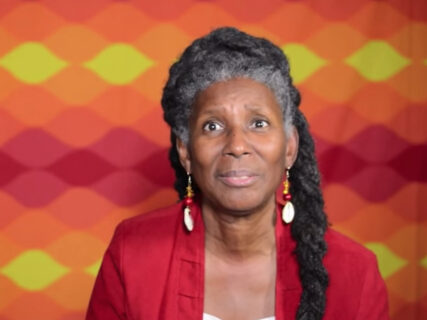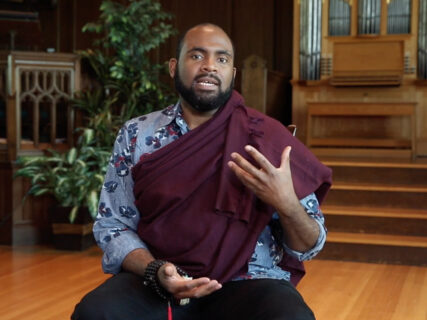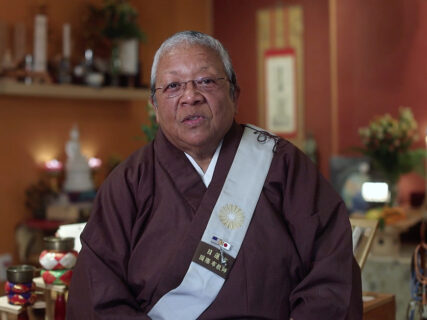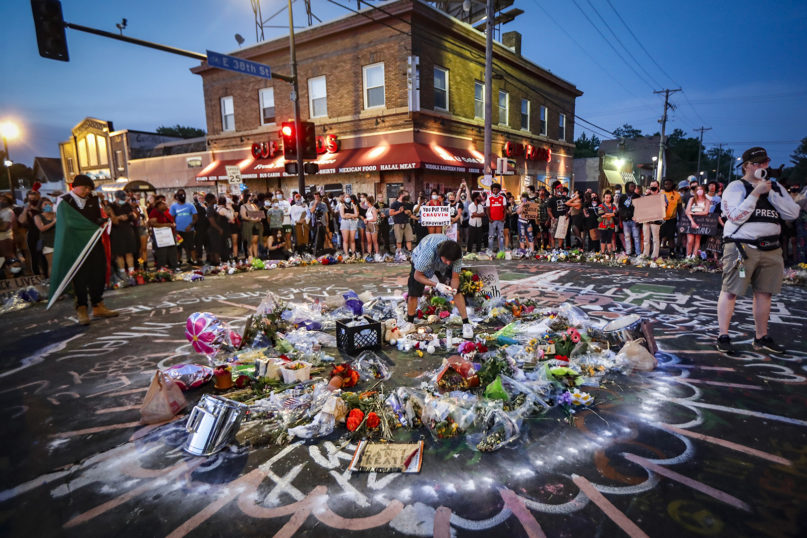(RNS) — Since nationwide protests erupted after the police killing of George Floyd, an unarmed Black man, in Minneapolis, Black religious leaders have reminded their flocks that racial injustice is nothing new. “The foot on the neck of George Floyd has been a foot that’s been there ever since Black people came to the U.S.,” said Arisika Razak in a recent talk in Oakland, California, as she urged her listeners to find common cause with other oppressed racial and ethnic groups.
What makes Razak’s graphic image surprising is that she is a teacher of Buddhism, a faith more often connected with quiet meditation than fiery exhortation. But as Razak addresses racial justice more frequently in her recent dharma talks — teaching sessions after group meditation — at Oakland’s East Bay Meditation Center, her view of this summer’s protest takes on a Buddhist bent. We are living through a “hinge time,” Razak tells her students, when the possibility for change, a core Buddhist tenet, is wide open.
Black people make up just 3% of the American Buddhist community, according to the Pew Research Center’s Forum on Religion and Public Life, but Black ordained and certified teachers can be found in all of the major Buddhist traditions and lineages in the U.S., said Rima Vesely-Flad, a professor at Warren Wilson College in North Carolina and author of the forthcoming book, “Black Buddhists and the Black Radical Tradition.”

Arisika Razak. Video screengrab
The Black Lives Matter movement and the broader reckoning with racism that took hold of the country this year has prompted these teachers to seek a practice that answers the moment and has called on the American Buddhist convert community, which has long been predominantly white, to focus more on anti-racism.
“We come to sit with others like us who understand our grief and our anger, our rage and our sorrow, our despair,” said Razak. “We come to a place that understands us.”
One shape this takes, said Vesely-Flad, is BIPOC — Black, indigenous and people of color — retreats and affinity sanghas, or Buddhist communities, at predominantly white meditation centers. Courses and lectures led by Black teachers have also become popular. The Rev. angel Kyodo williams, a Zen priest (who doesn’t capitalize her first or last name), addressed race, bodies and trauma in a recent virtual event. Meditation teacher Spring Washam is giving a weekly online class called “The Dharma of Harriet Tubman,” which examines the Buddha’s teachings alongside the history of Tubman’s work on the Underground Railroad.
These events give Black teachers space to focus on healing the trauma of daily racist interactions as well as crises like the killings of Floyd and Breonna Taylor, an unarmed Black woman killed by police in Louisville. “They’re saying, ‘Black people have been traumatized for so many generations — for centuries — that we also have to provide spaces that are culturally congruent and offer practices and rituals that support healing that are not about taking on the white dominant structure, but are about working on us,’” she said. “In some cases they are turning away from predominantly white institutions and saying, ‘What do we need to do to heal?’”
By and large, Black Buddhists’ practice is not significantly different from any other, but given the history of oppression, many Black Buddhists have emphasized practices that honor ancestors, a practice common throughout Asia but largely rejected by white convert communities.

Lama Rod Owens. Video screengrab
Lama Rod Owens, who was trained in the Tibetan tradition, said Buddhists from marginalized communities have long struggled to gain full representation in many white-dominated Buddhist institutions in the U.S., where they often feel “erased” and “unseen.”
While some white-dominated institutions have made efforts to address these issues, he said the work of “decentering whiteness” has been difficult and incomplete. (Many meditation centers have begun offering classes for white practitioners to recognize and deal with their “white fragility,” or defensiveness, when it comes to recognizing their own racism.)
Part of the task for Black Buddhist teachers, as for leaders of other faiths, is disentangling racist accretions from what is essential to the faith. “I’m a Black, queer teacher, and I have a right to embody my own culture and integrate it with the dharma,” said Owens, author of “Love and Rage: The Path of Liberation through Anger.”
“We have to look at the ways in which whiteness and Buddhism in America have been intertwined. And we have to say, ‘Actually, that’s not Buddhism or dharma, that’s just white supremacy,’” Owens said.
Owens believes Black Buddhists need to form their own networks to access all the tools Buddhism offers for healing trauma and navigating anger, despair and hopelessness.
In 2018 Myokei Caine-Barrett, bishop of the Nichiren Shu Order of North America and a priest at Myoken-ji Temple in Houston, did just that, helping organize a gathering of Black Buddhist teachers at Union Theological Seminary in New York to discuss what it means to be a Black Buddhist today. She said she did so in part because for years she had felt “solitary” as a Black practitioner.

Myokei Caine-Barrett. Video screengrab
Last year she helped put on another landmark event at Spirit Rock Meditation Center in California, which featured about 80 teachers and 300 community members. A third gathering is in the works, she said.
“There was a great deal of joy at finding each other and supporting each other and being able to truly walk each other home from some of the traumas that came up that other people were willing to share,” Caine-Barrett said. “Just finding a space where no one had to say to you, ‘Are you sure that happened?’ ‘Perhaps you misinterpreted?’ You didn’t hear that. It was just 100% acceptance and support. And it was truly beautiful.”
From these gatherings, she said they developed a national network that can identify needs in different parts of the country and send Black teachers there to fill them.
Now, amid the pandemic and uprisings, she said she’s seeing increased interest in Buddhist practices from people of color, and more BIPOC communities forming. Not only are people of color seeking each other out as a way of coping, she said, but they also now have an easier time doing so, since everything has shifted online.
Razak, of East Bay Meditation Center, which has long been a refuge for oppressed groups, said she is seeing a similar trend. Attendance at her people of color sangha grew after the killing of George Floyd, she said. Similar surges followed other high-profile police killings, including Oscar Grant, a 22-year-old Black Oakland resident killed by transit police, who became the subject of the film “Fruitvale.” She said it makes sense that oppressed groups are seeking out Buddhist teachings right now, given the dharma’s ability to help followers find joy in the present moment.
Erica Bridgeman, who has been attending the center for more than a decade, including Razak’s people of color sangha, said that having a space that centers racial justice and BIPOC practitioners has made all the difference in these tumultuous times.
“No matter what is happening out in the world, you walk into the space and you feel seen, you feel heard, you feel like you can breathe,” she said. “And that’s everything.”





